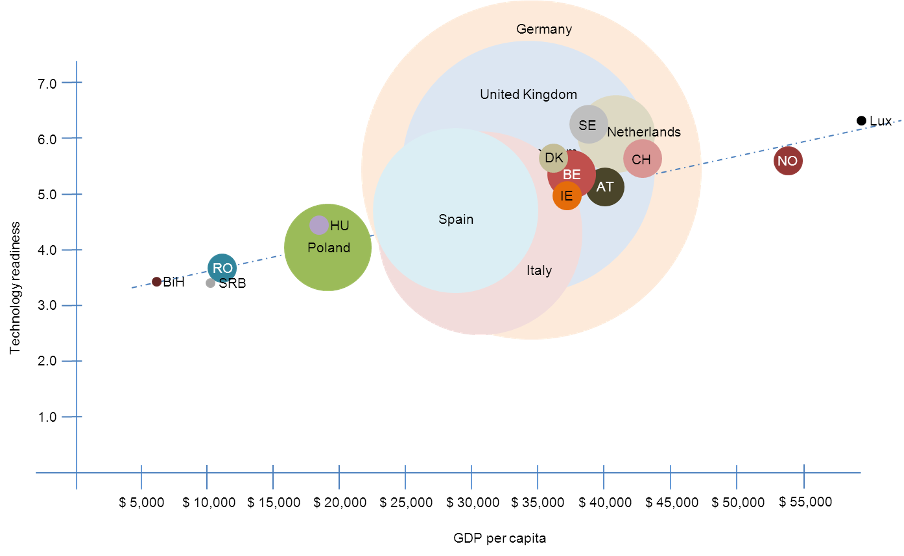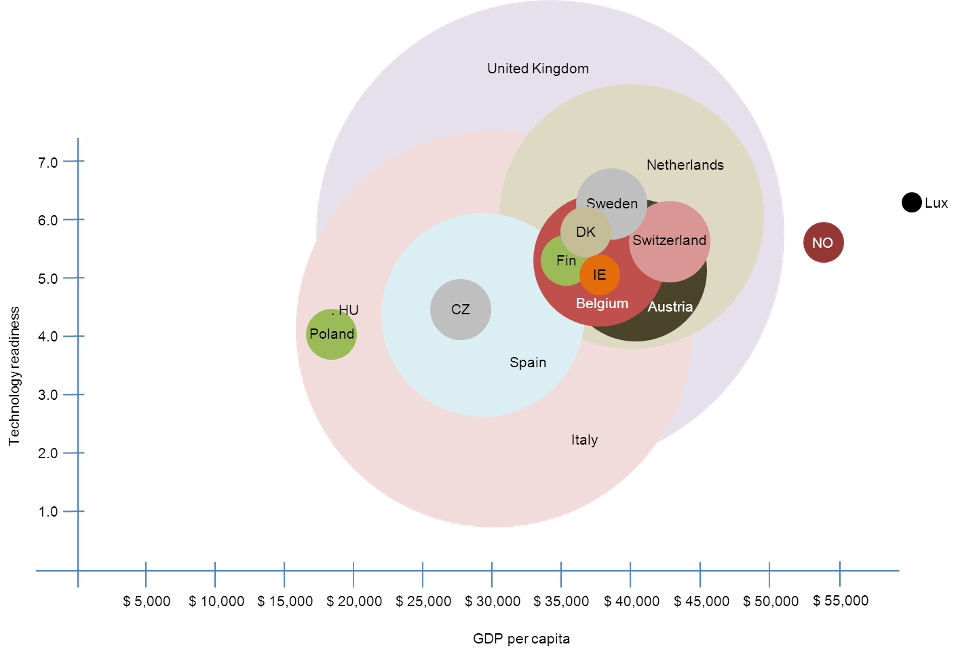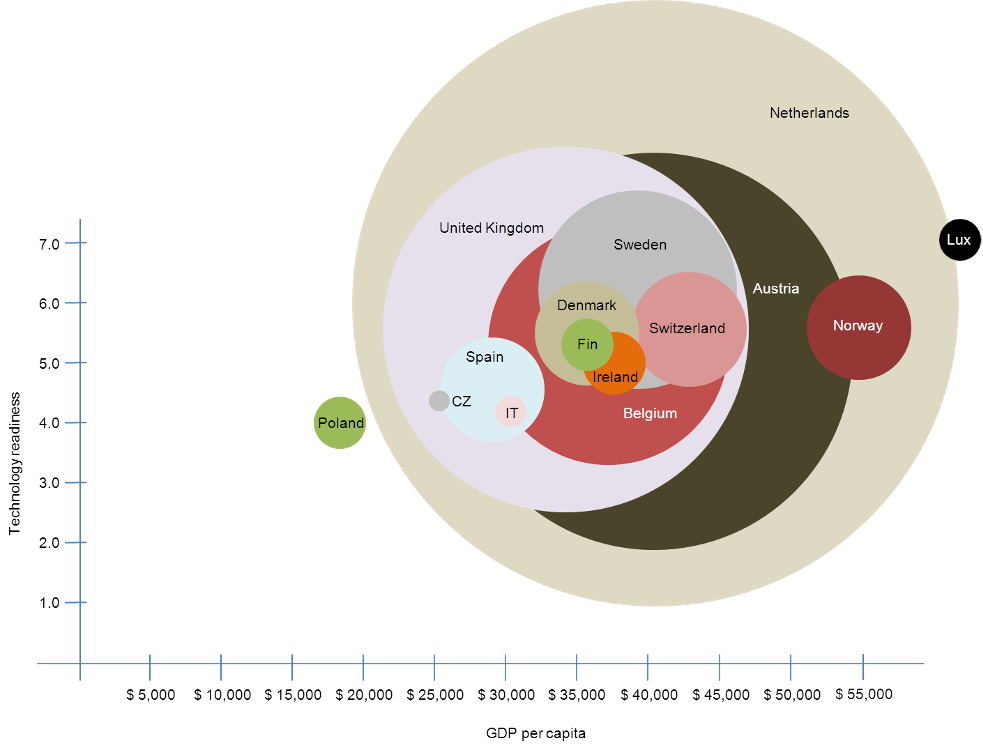The time has come to finalize the concept into the Global Expansion Framework Result. The outcome of the CPA-CAGE-PMA model, which has been introduced in previous blog posts.
It’s important to note that the full calculation details will not be shared here. This is not only due to the proprietary nature of the service offered but also because the interpretation and application of the values have been refined through extensive experience. Numbers and values can change over time.
The Global Expansion Framework consists of three distinct layers, which are as follows:
- Potential (CPA)
- Attractiveness (CAGE)
- Feasibility (PMA)
As mentioned in earlier posts, the initial step in the framework (CPA) is relatively straightforward. The attached graph illustrates the total potential market for several European countries, using data from 2010. Please note that the use of 2010 figures is intentional.

As the assignment focused on the technology attractiveness of a portfolio, the y-axis was used to represent the technology readiness of each country. Meanwhile, the x-axis displayed the GDP per capita for that specific period.
The size of each bubble represents the total market of each country. Using bubbles is a relatively simple and effective way to illustrate market size differences.
These numbers should come as no surprise to anyone. Additionally, the fact that Germany and the United Kingdom are positioned similarly in the table is not new. However, the key difference lies in the size of the market, which can make it challenging to display such data effectively, as smaller countries tend to become less visible in the diagram.
It’s important to emphasize once again—this is merely the beginning. Some companies still believe that this level of analysis is sufficient to conquer global markets with their products. That assumption should be reconsidered.
How attractive is another country?
A country’s market size may initially appear attractive due to its sheer volume, but how does it hold up when considering all the elements of the CAGE framework? In previous blogs, we explored the four key components of CAGE: Culture, Administration, Geography, and Economy.
Each of these factors plays a crucial role in determining a market’s true attractiveness. Once again, it’s important to emphasize that gathering and analyzing this information should not be taken lightly. This is likely the most time-consuming part of the entire exercise.
The next graph will illustrate the outcome when the CAGE elements are taken into account:

The first noticeable difference is the absence of one country compared to the CPA results—this would be the headquarter country, in this case, Germany. Additionally, you’ll observe that certain smaller countries have either grown in size or nearly disappeared.
The growth or reduction in the size of these bubbles is directly linked to the weighted values derived from the CAGE framework. Generally, the framework results in positive growth for market size, where applicable. However, Geography often introduces a constraint, particularly when a larger country is taken as the starting point for comparison.
Below, you’ll find some of the key weighted values used to recalculate the market size of each country. These numbers are based on Ghemawat’s 2002 research:
- Common language: +300%
- Trading bloc membership: +330%
- Common policies: +300%
- Common currency: +340%
- Landlocked status: -50%
- Shared land border: +80%
- Economic growth (1% increase): +0.8%
These weighted values are applied to each country in comparison to the HQ country, significantly influencing the overall market attractiveness.
The feasibility will be the outcome of the framework
Conducting a feasibility study is a crucial step when entering a new market. The final phase of the CPA-CAGE-PMA framework is the Product Market Analysis (PMA), which, combined with the earlier steps, provides a comprehensive feasibility assessment.
Using the previous example, this final step will result in adjustments to the market sizes as follows:

One of the first noticeable insights is that the Netherlands presents a larger opportunity than the United Kingdom. Two key factors contribute to this result:
- Market Saturation: Most competitors outside of Germany tend to target the UK as their first expansion market, making it quite overcrowded.
- Market Adaptability: Historically, the Netherlands has shown a higher rate of success in adopting German-made equipment, even when it is more expensive.
Based on this analysis, the initial steps for expanding abroad should prioritize the Netherlands and Austria. However, the United Kingdom remains an interesting market, albeit with more competition. Conversely, markets like Spain, Italy, and neighbouring Poland should likely be avoided in the first round of expansion.
It’s also worth considering the bundling of certain countries to enhance feasibility. For instance, in Europe, there are regional groupings like Benelux (Belgium, Netherlands, Luxembourg), ACH (Austria and Switzerland—often part of the DACH region with Germany), or the Nordics (Scandinavian countries). While these regions aren’t single markets, they are often treated as unified sales regions during the early phases of expansion. However, it’s important to be cautious, as each country within these regions has its own unique characteristics.
Final words
With this final and longest blog in the series, it should be clear that expanding a business internationally is not a simple task. However, there are frameworks that can guide you through the process, helping to identify the initial steps and prioritize which countries to target first, as well as those to consider in subsequent phases.
Approach global expansion step by step, just as you would when developing a product.
